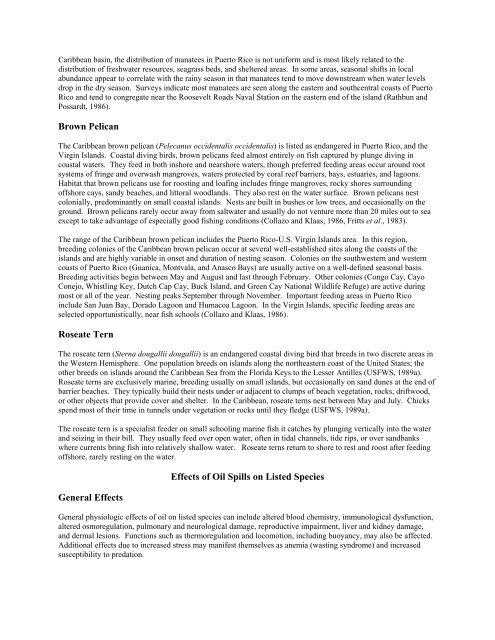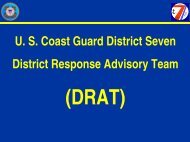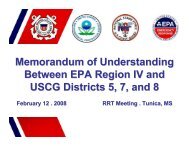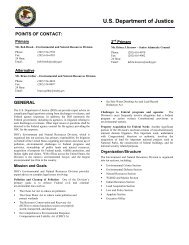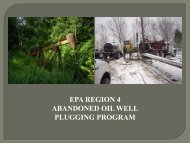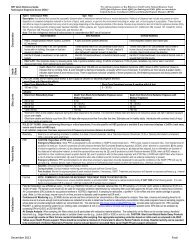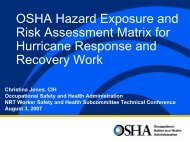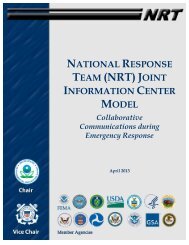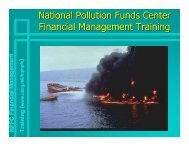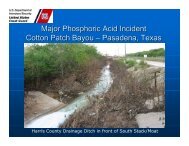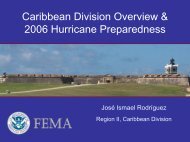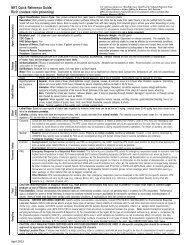USE OF DISPERSANTS - U.S. National Response Team (NRT)
USE OF DISPERSANTS - U.S. National Response Team (NRT)
USE OF DISPERSANTS - U.S. National Response Team (NRT)
- No tags were found...
You also want an ePaper? Increase the reach of your titles
YUMPU automatically turns print PDFs into web optimized ePapers that Google loves.
Caribbean basin, the distribution of manatees in Puerto Rico is not uniform and is most likely related to thedistribution of freshwater resources, seagrass beds, and sheltered areas. In some areas, seasonal shifts in localabundance appear to correlate with the rainy season in that manatees tend to move downstream when water levelsdrop in the dry season. Surveys indicate most manatees are seen along the eastern and southcentral coasts of PuertoRico and tend to congregate near the Roosevelt Roads Naval Station on the eastern end of the island (Rathbun andPossardt, 1986).Brown PelicanThe Caribbean brown pelican (Pelecanus occidentalis occidentalis) is listed as endangered in Puerto Rico, and theVirgin Islands. Coastal diving birds, brown pelicans feed almost entirely on fish captured by plunge diving incoastal waters. They feed in both inshore and nearshore waters, though preferred feeding areas occur around rootsystems of fringe and overwash mangroves, waters protected by coral reef barriers, bays, estuaries, and lagoons.Habitat that brown pelicans use for roosting and loafing includes fringe mangroves, rocky shores surroundingoffshore cays, sandy beaches, and littoral woodlands. They also rest on the water surface. Brown pelicans nestcolonially, predominantly on small coastal islands. Nests are built in bushes or low trees, and occasionally on theground. Brown pelicans rarely occur away from saltwater and usually do not venture more than 20 miles out to seaexcept to take advantage of especially good fishing conditions (Collazo and Klaas, 1986, Fritts et al., 1983).The range of the Caribbean brown pelican includes the Puerto Rico-U.S. Virgin Islands area. In this region,breeding colonies of the Caribbean brown pelican occur at several well-established sites along the coasts of theislands and are highly variable in onset and duration of nesting season. Colonies on the southwestern and westerncoasts of Puerto Rico (Guanica, Montvala, and Anasco Bays) are usually active on a well-defined seasonal basis.Breeding activities begin between May and August and last through February. Other colonies (Congo Cay, CayoConejo, Whistling Key, Dutch Cap Cay, Buck Island, and Green Cay <strong>National</strong> Wildlife Refuge) are active duringmost or all of the year. Nesting peaks September through November. Important feeding areas in Puerto Ricoinclude San Juan Bay, Dorado Lagoon and Humacoa Lagoon. In the Virgin Islands, specific feeding areas areselected opportunistically, near fish schools (Collazo and Klaas, 1986).Roseate TernThe roseate tern (Sterna dougallii dougallii) is an endangered coastal diving bird that breeds in two discrete areas inthe Western Hemisphere. One population breeds on islands along the northeastern coast of the United States; theother breeds on islands around the Caribbean Sea from the Florida Keys to the Lesser Antilles (USFWS, 1989a).Roseate terns are exclusively marine, breeding usually on small islands, but occasionally on sand dunes at the end ofbarrier beaches. They typically build their nests under or adjacent to clumps of beach vegetation, rocks, driftwood,or other objects that provide cover and shelter. In the Caribbean, roseate terns nest between May and July. Chicksspend most of their time in tunnels under vegetation or rocks until they fledge (USFWS, 1989a).The roseate tern is a specialist feeder on small schooling marine fish it catches by plunging vertically into the waterand seizing in their bill. They usually feed over open water, often in tidal channels, tide rips, or over sandbankswhere currents bring fish into relatively shallow water. Roseate terns return to shore to rest and roost after feedingoffshore, rarely resting on the water.General EffectsEffects of Oil Spills on Listed SpeciesGeneral physiologic effects of oil on listed species can include altered blood chemistry, immunological dysfunction,altered osmoregulation, pulmonary and neurological damage, reproductive impairment, liver and kidney damage,and dermal lesions. Functions such as thermoregulation and locomotion, including buoyancy, may also be affected.Additional effects due to increased stress may manifest themselves as anemia (wasting syndrome) and increasedsusceptibility to predation.


